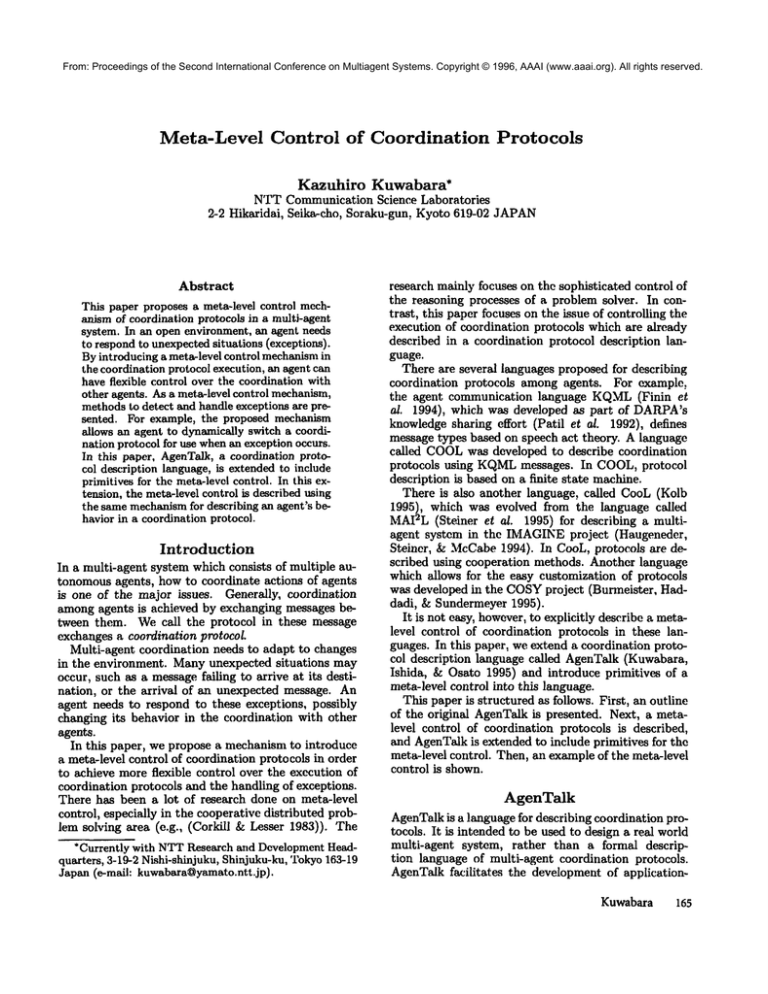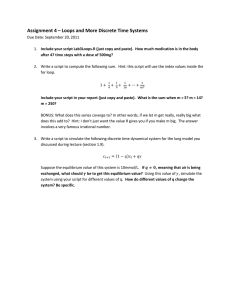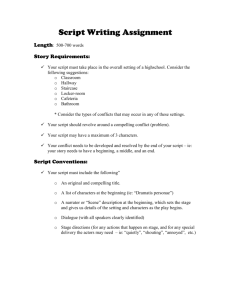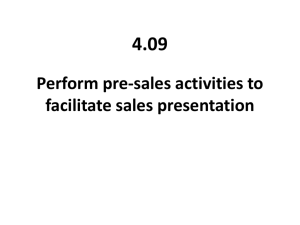
From: Proceedings of the Second International Conference on Multiagent Systems. Copyright © 1996, AAAI (www.aaai.org). All rights reserved.
Meta-Level
Control
of Coordination
Protocols
Kazuhiro
Kuwabara*
NTTCommunication Science Laboratories
2-2 Hikaridai, Seika~cho, Soraku-gun, Kyoto 619-02 JAPAN
Abstract
This paper proposes a meta-level control mechanism of coordination protocols in a multi-agent
system. In an open environment, an agent needs
to respond to unexpectedsituations (exceptions).
By introducing a meta-level control mechanismin
the coordination protocol execution, an agent can
have flexible control over the coordination with
other agents. As a mete-level control mechanism,
methodsto detect and handle exceptions are presented. For example, the proposed mechanism
allows an agent to dynamically switch a coordination protocol for use whenan exception occurs.
In this paper, AgenTalk, a coordination protocol description language, is extended to include
primitives for the meta-levcl control. In this extension, the meta-level control is described using
the same mechanismfor describing an agent’s behavior in a coordination protocol.
Introduction
In a multi-agent system which consists of multiple autonomous agents, how to coordinate actions of agents
is one of the major issues. Generally, coordination
amongagents is achieved by exchanging messages between them. We call the protocol in these message
exchanges a coordination protocol.
Multi-agent coordination needs to adapt to changes
in the environment. Manyunexpected situations may
occur, such as a messagefailing to arrive at its destination, or the arrival of an unexpected message. An
agent needs to respond to these exceptions, possibly
changing its behavior in the coordination with other
agents.
In this paper, we propose a mechanismto introduce
a meta-level control of coordination protocols in order
to achieve more flexible control over the execution of
coordination protocols and the handling of exceptions.
There has been a lot of research done on recta-level
control, especially in the cooperative distributed problem solving area (e.g., (Corkill & Lesser 1983)).
*Currently with NTTResearch and DevelopmentHeadquarters, 3-19-2 Nishi-shinjuku, Shinjuku-ku, Tokyo163-19
Japan (e-maih kuwabara~)yamato.ntt.jp).
research
mainly
focuses
on thesophisticated
control
of
thereasoning
processes
of a problem
solver.
In contrast,
thispaperfocuses
ontheissueofcontrolling
the
execution
of coordination
protocols
whicharealready
described
in a coordination
protocol
description
language.
Thereareseveral
languages
proposed
fordescribing
coordination
protocols
amongagents.For example:
the agent communication
languageKQML (Fininet
al. 1994),whichwas developed
as partof DARPA’s
knowledge
sharing
effort(Patilet al.1992),defines
messagetypesbasedon speechacttheory.
A language
calledCOOLwas developed
to describecoordination
protocolsusingKQML messages.In COOL,protocol
description
isbasedona finite
statemachine.
Thereis alsoanotherlanguage,
calledCooL(Kolb
1995),whichwas evolvedfromthe languagecalled
MAIL2 (Steiner
et al.1995)fordescribing
a multiagentsystemin the IMAGINEproject(Hangeneder,
Steiner,
& McCabe1994).In CooL,protocols
aredescribedusingcooperation
methods.
Anotherlanguage
whichallowsfortheeasycustomization
of protocols
wasdeveloped
in the COSYproject(Bunneister,
Haddadi,& Sundermeyer
1995).
Itis noteasy,however,
to explicitly
describe
a metalevelcontrol
of coordination
protocols
in theselanguages.
In thispaper.,
weextend
a coordination
protocoldescription
language
calledAgenTalk
(Kuwabara,
Ishida,& Osato1995)andintroduce
primitives
of
meta-level
control
intothislanguage.
Thispaperis structured
asfollows.
First,
an outline
of theoriginal
AgenTalk
is presented.
Next,a metalevelcontrol
of coordination
protocols
is described,
andAgenTalk
is extended
to include
primitives
forthe
meta-level
control.
Then,an example
of themeta-level
control
isshown.
AgenTalk
AgenTalkis a language for describing coordination protocols. It is intended to be used to design a real world
multi-agent system, rather than a formal description language of multi-agent coordination protocols.
AgenTalk facilitates
the development of applicationKuwabara
165
From: Proceedings of the Second International Conference on Multiagent Systems. Copyright © 1996, AAAI (www.aaai.org). All rights reserved.
_tScript:
nhe_rL’,p:from
~p_c_
.....
,,tripe-name,
-- ~_up?~-pcy_
_8c _ript-_V_a
ria _bles-y_ayl...
_._.......
Script-Functions:
£o.~c1 ....
calling an agentAgentProgram
functionfroma script
Script ~.g, ent function
.... ~}
~
agentfunction
%
-
.,.
}
Figure 2: Agent Function
Figure 1: Script Component
specific protocols by providing the following features:
¯ an inheritance mechanismas seen in object-oricntcd
languages to allow the incremental definition of protocols, and
¯ the interface for each agent to customize coordination protocols.
Description
Model
In AgenTalk, a coordination protocol is described
based on an extended finite state machine, and its representation is called a script. More specifically, the
behavior of an agent followiIlg a protocol is described
as a script. By introducing an inheritance mechanism
in the definition of a script, a script can be defined
incrementally, inlmriting the definition of an existing
script.
Script: A script is defined as a tuple of states, an initial state, state transition rules, script ~-ariables, script
functkms, and an inherited script (Figure 1). Script
variables can potentially have different values for each
invocation of a script. A local function in a script can
be defined as a script fimction.
State transition rule: A state transition rule in a
script definition consists of a condition part and an
action part. In the condition part, the following conditions can be written: (1) the condition on a message arrival (rest-condition), (2) the timeout condition
(timeout-condition),
and (3) the condition on script
variables (script-vat-condition).
In Agen’Ddk,a message is represented as an instance
of a m(,,~sage class, whichdeclares slots of its instance
(message). Thus, a message is represented as pairs
a slot and its vahm.There is also an inheritance of slot
declarations amongmessage classes.
The condition on a message arrival (ins.q-condition)
is represented as a messa.qe paitcrn, which contains
conditions regarding a message class, a sender of the
166 ICMAS-96
message, and slot values. Using an inheritance relationship amongmessage classes, it is defined that a
message can match the message pattern which specifies the super class of the message.
In the action part, various procedures can be written
including (1) the state transition to another state, (2)
the update of script variables, and (3) the control
the script execution, which is described later.
Agent function: A script has an interface
with
which an agent can customize the protocol. This interface is called an agent function, and it is a kind of
callback fimction, to be called from the state transition rules during the script execution. A protocol (:an
be customized for each agent by defining its ownagent
function.
The current version of AgenTalk is implemented in
CommonLisp and uses S-expression-like syntax. The
syntmxof the script definition is dcscribed in Figure 3.
The define-script
macro declares a script, and the
define-script-state
macro defines a state and state
transition rules which are to be active in the state. In
addition, the define-scr±pt-state
macro can defin(’
a procedure which is to be invoked when a state transition to the state being defined occurs (:on-entry
option).
Execution
Model
Whenan agent decides to follow a certain protocol, it
invokes a corresponding script. Onceinvoked, a script
is b~Lsically executed as follows: first, a state transition rule whose condition part holds is selected from
currently active rules; next, its action part is executed;
then the script execution goes back to the first step.
Meta-Level
Control
In the proposed mel.a-l(,vel control mechanism,a script
is utilized to control the execution of another script. In
other words, a script describes a (meta-level) control
of a protocol (script). Describing the script control
mechanismby a script itself makes it possible to utilize the inheritance and customization mechanismsof
script definitions.
From: Proceedings of the Second International Conference on Multiagent Systems. Copyright © 1996, AAAI (www.aaai.org). All rights reserved.
(define-script script-name lambda-list {script-options}*)
script-options ::= :initial-state
initial-state-name
[ :script-wars ({script-vat I (script-vat initial-value)}*)
[ :inherits-froffl script-name
(define-script-state
(state-name script-name) [:on-entry lisp-~orm] [:rules
rule ::= (:when condition :do action) [ :inherited
condition ::= meg-condition ] timeout-condition
[[ msg-conditionI timeout-condition ] script-vat-condition
meg-condition ::= (meg message-class [sender] {slot-name value-pattern}*)
timeout-condition ::= (timeout lisp-form)
script-vat-condition ::= (test lisp-form)
({rule}*)])
Figure 3: Syntax of Script Definition (in part)
Meta-level
script
The top-level script, which is invoked when an agent
is started, can be viewed to provide a meta-level control of protocols. That is, this top-level script will
invoke scripts of domain-level protocols as necessary
(Figure 4). By using the agent function interface, the
top-level script itself can be customized for each agent.
In addition, the top-level script can be extended inheriting the definition of a basic top-level script.
tol~-level
invocation~
Domain-level
Script1 ~"
~i
"~
Script2
.,,
~
Figure 4: Top-level Script
Script
Invocation
Another script can be invoked using the run-script
function at the action part of a state transition rule.
The script which invokes another script is called a parent script, and the invoked script is called a child
script. Basically, multiple scripts can be executed
1
concurrently.
Whenan agent receives a message, it searches the
state transition rules in the currently invoked scripts
for a rule whose condition part holds. This search
starts at the most recently invoked script and continues in the reverse order of the script invocations. That
is, a child script is searched before its parent script,
and the initially invoked script is searched last. Thus,
a parent script can be used to handle background jobs
(with lower priority), while child scripts handle each
individual jobs.
IThere is also another modein the invocation of a script,
whichsuspendsthe execution of a parent script temporarily
until the execution of a child script terminates. This mode
is provided mainly for a programmer’sconvenience.
Script
Execution
Control
Primitives
The run-script
function returns a script execution
contezt. The context holds the information regarding
the execution of a script. Whenmultiple scripts are invoked, a context is created for each script invocation.
Froma context, the current state, parent context, child
context(s), and descendent context(s) can be obtained
(Table 1). A script variable can have a context as its
valuc. By describing a condition on the script variables in a state transition rule, a script can control the
execution of another script based on the status of the
script execution.
In addition to run-script, there are other primitives provided for controlling the execution of a script.
They can terminate, suspend, and resume the execution of a script taking a context as an argument (Table 2).
Detecting
Exceptions
The main goal of the rests-level control described in
this paper is to handle unexpected situations. Therefore, it is necessary to detect an exception and notify
the (meta-level) script execution (program) of the
ception occurred. Basically, exceptions are detected either by an AgenTalksystem or by a meta-level script.
The former case includes a message delivery problem,
and the latter case includes a message which no currently activated scripts can handle.
In order that an exception can be notified, a message
class exception is defined. For each specific exception,
its derived class is defined. The examples are as follows.
Kuwabara
167
From: Proceedings of the Second International Conference on Multiagent Systems. Copyright © 1996, AAAI (www.aaai.org). All rights reserved.
Table 1: Primitives for Accessing a Script Execution Context
primitive
description
current-state
context
rcturns
a current
statename
returns
a context
ofan immediate
parent
parent-context
context
child-contexts context
returns a list of chUdc.ontcxts
descendant-contexts context returns a list of descendant contexts
Table 2: Primitives for Script Execution Control
primitive
run-script
script-name-and-options (argument}*
exit-script [ return-value ] [ context]
suspend-script
[ context]
resum¯-script [ context
I
Message delivery error: When a message fails to
be delivered, the AgenTalk system sends a message of
the message-not-delivered class, which is a subclass
of exception, to the sender agent. A state transition
rule which handles this type of message can be defined
to describe an action to be taken when a message d~.
2livery problem occurs.
Message unmatched: At least one state transition
rule in currently activated scripts shoukl match an incoming message. Whena message which does not have
a matching state trazmition rule arrives, it should be
considered an exception, and an exception noti~’ing
message(message-unmatched,
whichis a subclass
of
exception)
is senttotheagent(areceiver
of theoriginalmessage).
More specifically, the top-level script has a state
transition rule whose condition part matches any me.ssage. Since the top-level script will bc searched last,
this rule will be fired only when no other scripts have
a matching rule. The action part of this rule is to
senda message
of themessage-unmatched
classto the
agent.A userneedsto definea scriptwhichhandles
this message-unmatched
message.
Coping with Exceptions
An agentneedsto respondto the exceptions.
In this
section, a mechanism to handle a message-unmatched
exception is described. T|m basic idea is to search for
a script which can handle the unmatched message and
c~ange the script of az~ executing context to the script
found. Using this mechanism,it is possible that a lmsic
protocol (script) is invoked first, and an agent changes
the executing script to an extended and more specific
protocol (script) as the nc~darises (i.e., the arrival
a message which cannot be handled).
"Thiskind of state trmmitionrule is often in effec! in all
states. Thus, there is a wayto define this kind of exception
handlingrules separately from typical state transition rules.
168 ICMAS-96
d~cription
invokcsa script
terminates the script execution
suspends the script execution
resumestile script execution
This default behavior is defined in the top-level
script. Since a matclfing ,~tatc transition rule is
searched for in the reverse order of the script invocations, this default behavior can be overridden hy invoking a script which contains a rule that can handle
a message-unmatched message.
AgenTalksupports an inheritance in the script definitions. This inheritance relationship is utilized to
change the executing script dyna4zfically. Wecall a
script whosedefinition is inherited a superclass script,
and a script which inherits the definition of another
script a subclass script.
A primitive change-script
is introduced which
changes the executing script of a context to another
script. 3 In order to change the executing script, the
following conditions must be met.
¯ Both original and new scripts must have the same
supercla.ss script (including itself).
¯ The state with the same name of a current state of
the context must exist in a new script.
The former condition can reasonably limit the range of
scripts when a n(:w script is searched for. The latter
condition ensures that the current state can be determinedin a newscript. If the script of a context changes
from a superclass script (more general one) to a subclass script (more specific one), the above conditions
will hold, since a new script will have a state wil.h the
same name as the current state, inheriting from the
superclass script.
Whenthe script of a context changes, s(’ript variables may also change. Whena script variable is no
longe.r necessary in a new"script, the current value of
the variable is temporarily stored. Whenthe executing script is changed later and a script variable with
3Whenwe view a ~ript definition as a class definition,
and its exet:uting context as an instance of a clmss ms in
object-oriented languages, changingthe executing scrip! of
a context correspondsto changingthe class of an instance
(e.g., change-class in Common
Lisp).
From: Proceedings of the Second International Conference on Multiagent Systems. Copyright © 1996, AAAI (www.aaai.org). All rights reserved.
; ; ; script declaration
(define-script
top-level ()
:initial-state
’start)
; ; ;state transition rules
(define-script-state
(start top-level)
: rules
; ; this rule matchesa message-unmatched
message.
(( :when (msg message-unmatched:message ?msg)
; ;find a script whichcan handle the message(?msg).
; ; context re/ers to the current execution context.
; ; note lhat Common
Lisp functions/macros can be used here.
:do (let ((context-list
(descendant-contexts context)))
; ; try eachcontext in the descendantcontexts.
(dolist (this-context context-list)
; ; is an appropriatescript found?
(let ((scripts (find-script
this-context ?msg)))
(whenscripts
; ; i/found, changethe executingscript of this context to the top o/the script list.
(change-script this-context (car scripts) ?meg)
; ; exit the dolist.
(return nil) ) ) )
; ; other default rules such as handling a message-not-delivered
messageshould comehere...
; ;the last rule matchesany message.
(:when (meg message)
; ; send an exceplionnotifying messageto itself (self).
:do (send-message self ’message-unmatched:message meg))
))
Figure 5: Example Code of the Top-level Script (in part)
the same name is needed again, the previously stored
value is restored.
The primitive change-script has an optional argument unmatched-message so that the message which
has triggered the script change can be processed when
change-scr±pt is called. In addition, a primitive
(find-scripts) is provided to find a list of candidate
scripts from ( a library of) existing scripts. This primitive takes a context and an unmatched message as
its arguments and returns a list of possible scripts to
which the executing script of a given context can be
changed. Using these primitives, an example top-level
script can be written as seen in Figure 5.
Example
Let us consider an example taken from the contract
net protocol (Smith 1980). The basic contract net protocol uses a task announcement, a bid, and an award
to allocate a task among agents. The state transition of a manager agent, which allocates a task to
another agent, can be described as seen in Figure 6
(the state transition diagram) and Figure 7 (the sample code) (Kuwabara, Ishida, & Osato 1995). After
manager agent broadcasts a task announcement message, it waits for a bid message, and the manageragent
sends an award message if a proper bid is received.
Manyextensions to the basic contract net protocol
are possible. For example, when an agent receives a
task announcement but cannot send back a bid, the
agent may send aa immediate response bid (Smith
1980) to notify the manager agent of the reason why
a bid cannot be sent. Similarly, we can consider a
counter proposal to the task announcement instead of
a bid. This counter proposal message would suggest a
task specification the agent can handle. If we incorporate this extension, a counter proposal message needs
to be handled in the announced state in addition to
bid messages. Whena manager agent recognizes that
an award cannot be sent, it checks the counter proposal messages received so far and decides whether it
goes back to the start state and sends another (possibly
modified) task announcement (Figure 8 and Figure 9).
Let us suppose that agents cannot decide which specific extension of the contract net protocol to use at
the start. Using the script change mechanism described above, an agent can start with the basic proKuwabara 169
From: Proceedings of the Second International Conference on Multiagent Systems. Copyright © 1996, AAAI (www.aaai.org). All rights reserved.
(define-script cnet-manager (task)
: initial-state~ start
:script-vars (bid-queue contract-id))
; ; ; start state
(define-script-state
(start
chef-manager)
; ;broadcast a task-announcementmessageby invoking the agent/unction almotmce-task.
:on-entry (progn (set/ ($ contract-id) (! announce-task))
(goto-state ~ announced)))
; ; ; announced
state
(define-script-state
(announced
cnet-manager)
: rules
; ; wait/or a bid messagewith the samecontraet-id.
((:when(msgbid :contract-id
!($contract-id))
:do (if (! send-award-immediately-if-possible
msg)
(goto-state
~ success)
(push msg ($ hid-queue))))
; ; checka timeoutcondition.
(:when (timeout
(task-expiration
:do (if (! send-award-if-possible)
(Eoto-state~ success)
(goto-state
’ failure)) )
task))
; ; ; successstate
(define-script-state
(success cnet-manager)
:on-entry (exit-script
t))
; ; ;failure state
(define-script-state
(failure oust-manager)
:on-entry (exit-script nil))
Figure 7: Example Script of a Manager in the Contract Net Protocol
cnet-manager
~
Task Announcement
.~
Bid
(announced ~ Award
",
" \ Immediately?
Tirneout
Send an Award?No I Yes
message-unmatched
exception message to the agcnt.
This message results in switching the executing script
to the cnet-manager-w±th-counter-proposal
script
(Figure 10).
Of course, it is possible to define a script whichincludes all the possible extensions and invoke that script
from the start. Hov,~ever, as a protocol becomescomplicated, it maynot be possible to define a script which
(:an handle all the extensions, because someof the extensions may be incompatible with each other. In such
a case, switching the executing script is useful.
Conclusion
Figure 6: State Transition of a Manager in the Contract Net Protocol
tocol (cnet-manager script) and switch the executing
script to the extended script when a message which
cannot be handled by the current script arrives (in this
case, cotmzer-proposal).
When such a message arrives, the default rule in the top-level script sends a
170
ICMAS-96
This paper described the meta-level control of coordination protocols and presented a way to implement it
as an extension to AgenTalk. The primitives for controlling the script execution are introduced and a script
itself is used to control the execution of other scripts.
Currently the meta-level control mechanism descrit)ed
in this paper is being implemented in
AgenTalk. In addition,
AgenTalk is planned to
be extended to represent the procedural knowledge (Georgeff & Lansky 1986) of an agent. The original vcrsion of AgenTalkwhich runs on Allegro Corn-
From: Proceedings of the Second International Conference on Multiagent Systems. Copyright © 1996, AAAI (www.aaai.org). All rights reserved.
(define-script
cnet-manager-with-counter-proposal
(task)
: script-vars
(counter-proposal-list)
: inherits-from
cnet-manager)
; ; ; redefine the announcedstate.
(define-script-state
(announced cnet-manager-with-counter-proposal)
: rules
(; ;state transitionrulesare inherited.
: inherited
; ; a state transition rule whichhandlesa counter-proposal
messageis added.
(:when (msg counter-proposal
:contract-id
! ($ contract-id))
; ; record counter proposals.
:do (push msg ($ counter-proposal-list)))))
; ; ; redefine the failure state.
(define-script-state
(failure
cnet-manager-vith-counter-proposal)
; ; check counter proposals received so far.
:on-entry (if (! retry-using-counter-proposal-p)
; ;go back to the start state.
(goto-state
’start)
; ;exit the execution o/this script.
(exit-script
nil)))
Figure 9: ExampleScript of a Managerin the Extended Contract Net Protocol with a Counter Proposal
cnet-manager-wlth-counter-proposal
cnet-maflsger
J:
""":’::’{
............
~r
~,...~ ...........
/
i ..-"
"~
¯ i,"...................
success
j
Proposal
~,j~
1/"""’; ......... ~
I; fadure~
. i
/
!__:’=
........
:_:’
...............
~:::::::::_~_
..........L.,
Figure 8: Extended Contract Net Protocol with a
Counter Proposal
menLisp and MacintoshCerumenLisp is available as
4free. software.
The meta-level control mechanismproposed in this
paper is rather simple one. For example,it is not easy
to makecertain that an unmatchedmessage is a responseto the previously sent message.Moreover,since
multiple script execution contexts mayexist in one
agent simultaneously, the meta-level control mechanism needs to find an appropriate context whenswitch4U’RL: http://www, cslab,
tas. ntt.
jp/at/
ing a script. Currently,selecting the correct context is
up to a user; in a user program, a messageclass may
need to have a slot which holds an ID of a message
exchangesequence (conversation) in order to distinguish between script execution contexts. Extending
the AgenTalklanguage to handle these matters more
easily is left for the future work.
Finally, weplan to evaluate the mechanism
proposed
in this paper by building multi-agentapplications such
as a conferenceregistration support system.
Acknowledgments
The author would like to thank Toru Ishida and
Nobuyasu Osato, the co-designers of the original
AgenTalk. He would also like to thank Kazunori
Asayama,Motohide Otsubo, Takuji Shinohara, Isoo
Ueno, and Sen Yoshida for their contributions to the
AgenTalklanguage and its implementation.
References
Burmeister, B.; Haddadi, A.; and Sundermeyer, K.
1995. Generic, configurable, cooperationprotocols for
multi-agentsystems. In Castelfranchi, C., and Miiller,
J.-P., eds., ~m Reaction to Cognition, MAAMAW
’93, Lecture Notes in AI 957. Springer-Verlag. 157171.
Corkill, D. D., and Lesser, V. R. 1983. The use of
meta-level control for coordination in a distributed
problem solving network. In Proc. 8th International
Joint Conferenceon Artificial Intelligence (IJCAI
’83), 748-756.
Kuwabara 171
From: Proceedings of the Second International Conference on Multiagent Systems. Copyright © 1996, AAAI (www.aaai.org). All rights reserved.
top-level
a Counter
Proposal
message
arrives
whileat theannounced
state
The
bas~cne~
script~ mvoked
/
a message-unmatched
exceptionoccurs
cnet-manager
TaSkAnnouncement
S/d
cnet-maneger-wlth-counter-proposll
cne|-rltOl~ager
find a script whichcan
handlethis message
~rd
( find-ncrlpt
I)
y?
change
the executing
script
accordingly
( change-script
1
,
"~.
i
/"
"~"’Counter
Proposal
/ .......
,.
I................
N°I , IY~’I :
¯
¯...............
~...............
, )J
~-’_
Figure 10: Example of a Script Change
Finin, T.; Fritzson, R.; McKay,D.; and McEntire, R.
1994. KQML
as an agent communication language. In
Proc. Third International Conference on Information
and Knowledge Management (CIKM ’94).
Georgeff, M. P., and Lansky, A. L. 1986. Procedural knowledge. Proceedings of the IEEE 74(10):13831398.
Haugeneder, H.; Steiner, D.; and McCabe, F. G.
1994. hnagine: A framework for building multiagent systems. In Proc. Second International Working
Conference on Cooperating Knowledge Based Systems
(CKBS’g4), 31-64.
Kolb, M. 1995. A cooperation language. In Proc.
First International Conference on Multi-Agent Systems (ICMAS ’95), 233.238.
Kuwabara, K.; Ishida, T.; and Osato, N. 1995.
AgenTalk: Describing multiagent cx)ordination protocols with inheritance. In Proc. 7th IEEE Inte~’aational Conference on Tools with Artificial Intelligence
(ICTAI ’95), 460-465.
Patil, R. S.; Fikes, R. E.; Patel-Schneider, P. F.;
Mckay, D.; Finin, T.; Gruber, T.; and Neches, R.
1992. The DARPA
knowledge sharing effort: Progress
report. In Nebel, B.; Rich, C.; and Swartout, W., eds.,
Principles of KnowledgeRepT~’.sentation and Reasoning: Proceedings of the Third International Conference. Morgan Kaufmann.
Smith, R.O. 1980. The contract net protocol:
High-level communicationand control in a distribur.ed
problem solver. 1EEE Transactions on Computers
29( 12):1104-1113.
172 ICMAS-96
Steiner, D.; Burt, A.; Kolb, M.; and Lerin, C. 1995.
The conceptual framework of MAI2L. In Ca.~’telfranchi, C., and Miiller, J.-P., eds., From.Reaction to
Cognition, MAAMA
W ’93, Lecture Notes in AI 957.
Springer-Verlag. 217-23(}.








